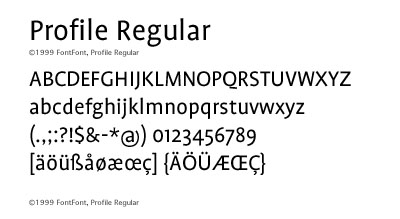dot-font: Profile of a Modern Sans Serif

dot-font was a collection of short articles written by editor and typographer John D. Barry (the former editor and publisher of the typographic journal U&lc) for CreativePro. If you’d like to read more from this series, click here.
Eventually, John gathered a selection of these articles into two books, dot-font: Talking About Design and dot-font: Talking About Fonts, which are available free to download here. You can find more from John at his website, https://johndberry.com.
One of those rules of thumb we love to repeat to ourselves, especially in the United States, is that sans serif typefaces are inherently less readable in extended text than typefaces that have serifs. Sans serifs, the logic goes, are mechanical and lifeless; they’ve sacrificed the subtle warmth of an old-style serif typeface to the cold, cruel logic of the machine age. Yet this assumption has been challenged over recent decades by a significant number of type designers, most of them in Europe, who seem intent on creating a sort of warm modernism.
All this came to mind recently when perusing a new sample book from FontShop, which showcased FontShop’s FF Profile typeface. FF Profile is one of a growing number of sans serif typefaces that are characteristically clean and spare in appearance but that have little to do with established sans serif categories—the clunky 19th-century tradition of serifless grotesques or the rational, modernist 20th-century tradition of geometrical sans serifs.

This sample of FontShop’s FF Profile typeface shows the character set for its regular weight.
The Humanist Tradition
Of course every tradition needs an easily referenced and readily identifiable name, and these new variants march under the banner of “humanist sans serifs.” The name seems apt given their warmer design, but its genesis is well rooted in typographic history: These typefaces are based on the humanist handwriting of the 15th century and the old-style typefaces that followed them (and that dominated printing until nearly the time of the French Revolution).
Today’s humanist sans serifs follow those Renaissance forms, but they are stripped of their ornamentation and most of their contrast, reduced to their essential forms and then reconstituted in a variety of weights. One characteristic of almost all humanist sans serifs is that they have true italics, not just slanted romans as so many other sans serifs do.
FF Profile was designed by Martin Wenzel, a 32-year-old German designer from Berlin who studied in the Netherlands and now works in Delft with Buro Petr van Blokland + Claudia Mens. Even if you didn’t know he’d been a student at the Royal Academy for Fine and Applied Arts, in the Hague, it would be obvious to anyone with an eye for the fine points of type that he’d been influenced by the humanist Dutch typographic tradition. Profile clearly grows out of some of the same ideas and concerns that gave us Petr van Blokland’s Proforma and Luc(as) de Groot’s Thesis. (It also has some details in common with Erik Spiekermann’s Meta, which approaches the same problems from a somewhat different direction.)
The challenge with a sans serif typeface like this is to make it varied enough for comfortable reading in long blocks of text, yet simple and unornamented enough to define its space on the page. It should suggest an uncluttered, modern, clearly delineated world.

FontShop’s “FontFont Focus” specimen book displays FF Profile in lower case and small caps.
Disclaimer: I’m judging Profile entirely from printed samples; I’ve never put the fonts to use. And of course the new type-specimen booklet from FontShop (the fifth in its “FontFont Focus” series) is handsomely designed, in a way that would show any typeface off to its best advantage. The samples make me want to try out the face in various designs and layouts, much the way Thesis appealed to me the very first time I saw it. Profile has the same clarity and slim elegance that Thesis has, and a similarly open, spacious appearance. But Profile has a slightly warmer, less stark look, because of detailing like the small, skewed swellings at the ends of some strokes. Without jumping around or being too lively, Profile possesses a slight informality that makes it feel friendly.
Fine Details
Wenzel has given Profile humanist characteristics in the roman, such as the open aperture and small eye on the lowercase a and e, as well as a traditional two-story g. The italic, he points out, “is gently oblique and runs a little narrower and lighter than the respective roman.” Both roman and italic are spaced generously, not crowded together like an advertising headline face. The ends of some of the strokes are asymmetrical; in the v, for instance, the angles of the ends of the two arms are different.
Profile comes in five weights, and each includes roman, italic, small caps, and no fewer than five different sets of numerals: old-style (the standard), lining, monospaced old-style (for tables and columns of figures, as in an annual report), and small lining figures in both the superscript and baseline positions (for making fractions, among other things). Wenzel has provided a number of simple but useful ornaments, such as arrows in various directions and dotted lines and boxes, as well as such unusual characters as a euro symbol with only one crossbar (in addition to the standard one with two crossbars) and an alternate at sign that, as Wenzel puts it, “takes the at literally, as a ligature of a and t.” He even created appropriate versions of the various mathematical symbols that are part of every standard digital font, but that many type designers just let default to Symbol.

Interesting FF Profile touches include an alternative at symbol that represents the symbol as a ligature of a and t.
The Recipe
After describing some of the influences on the design of Profile (and making the usual disclaimer that it wasn’t based directly on any particular face), Wenzel whimsically describes what he calls “the recipe”:
“Take the forms of classical typefaces based on writing with a broad nibbed pen (for example, a Garamond). Then, carefully reduce the contrast within the character shapes (the thicks and the thins) to a minimum. To finish, reduce the serifs so that only a little detail will remind us that they were once there. Serve unscaled and with enough leading.”
Not a bad recipe for the typographic cuisine of the 21st century. We have a lot of fine reading ahead of us.
This article was last modified on March 24, 2022
This article was first published on August 3, 2001





Try this link to FF Profile: https://www.fontfont.com/cgi-bin/showfont.pl?name=ff+profile
Valerie,
why do you think that so many web articles are in sans? its because the serifs are lost at article type sizes onscreen and hinder legibility. look at any article on screen typography and it will tell you the same
I want to know how to purchase this font. I do not find a URL for FontShop this would be helpful.
Duane Toutjian
Sans serif typefaces, called by any name, are inherently more difficult to read in quantity. THAT’S why they shouldn’t be used as text. And the fact that the article was written in a sans serif type (as are most Web articles) only serves to reinforce the argument against sans serif as body copy.
none
Among the dozens of new font releases each month, Berry
has chosen a great one to review. He explains why Profile
is a significant new contribution, and I can’t wait so see
it in action, as well as more Berry font reviews!
hhp